21 died on 6 eight-thousanders; Traffic Jam, Weather, or Incompetence?
Yet another demise of American lawyer Christopher John Kulish (61) on 27th May, death toll hits 11 only on Everest in this climbing season. To everyone’s astonishment, amongst 21 of who perished on six different eight-thousanders in the Himalayas, 17 of them lost their lives within 9 days. So far, 9 of them have been brought back down either to the respective Base Camps or flown back to Kathmandu.
Amid few aborted rescue operations such as of the Trinity College professor Seamus Sean Lawless (39) and Chilean mountaineer Rodrigo Vivanco (52), stern concerns have been raised in terms of how defensive a mountaineer is entitled to be while climbing the coveted eight-thousanders. Dissimilar to the situations of technically advanced climbers, serious apprehensions have been upstretched to put a veto on a lesser amount of methodological familiarity in the field of mountaineering.
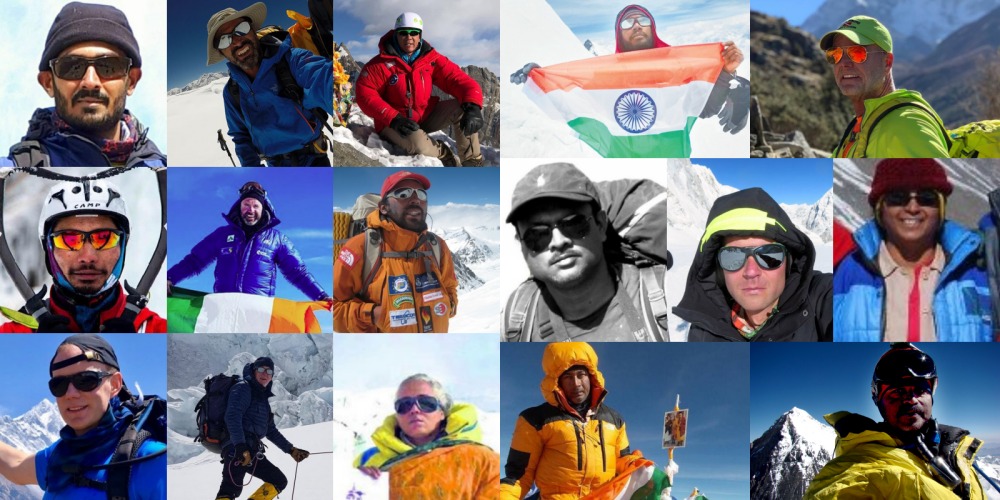
Climbers who lost their life in Spring, 2019
What pushed the death toll to 21?
Since the demise of Malaysian doctor and mountaineer Wui Kin Chin (48) even after his successful rescue at Annapurna, the deaths took a serious toll on Everest, Lhotse, Makalu and Cho Oyu, and Kanchenjunga so far.
Doyens of the mountaineering fraternities around the world, have overwhelmingly put forth various reasons to the escalating death rate in the Himalayas in a week’s time without having any natural disaster taken place. Few are attributing inexperience as the driving factor in some cases, whereas, others are condemning the harsh weather. First 2 weeks of May were barely satisfactory to fix the rope and open the route due to harsh weather issues. Hence, the mountaineers’ mob that aimed at different timelines to summit the 8-thousanders, had to push back their date of attempts, leading to the much talked-about traffic jam of the season above or around the ‘Death Zone’. Through the South-East Ridge, as the awaiting climbers ascend up the Balcony from South Col, the returning climbers who are descending from South Summit, come face-to-face, causing the world’s most discussed traffic jam on Everest.
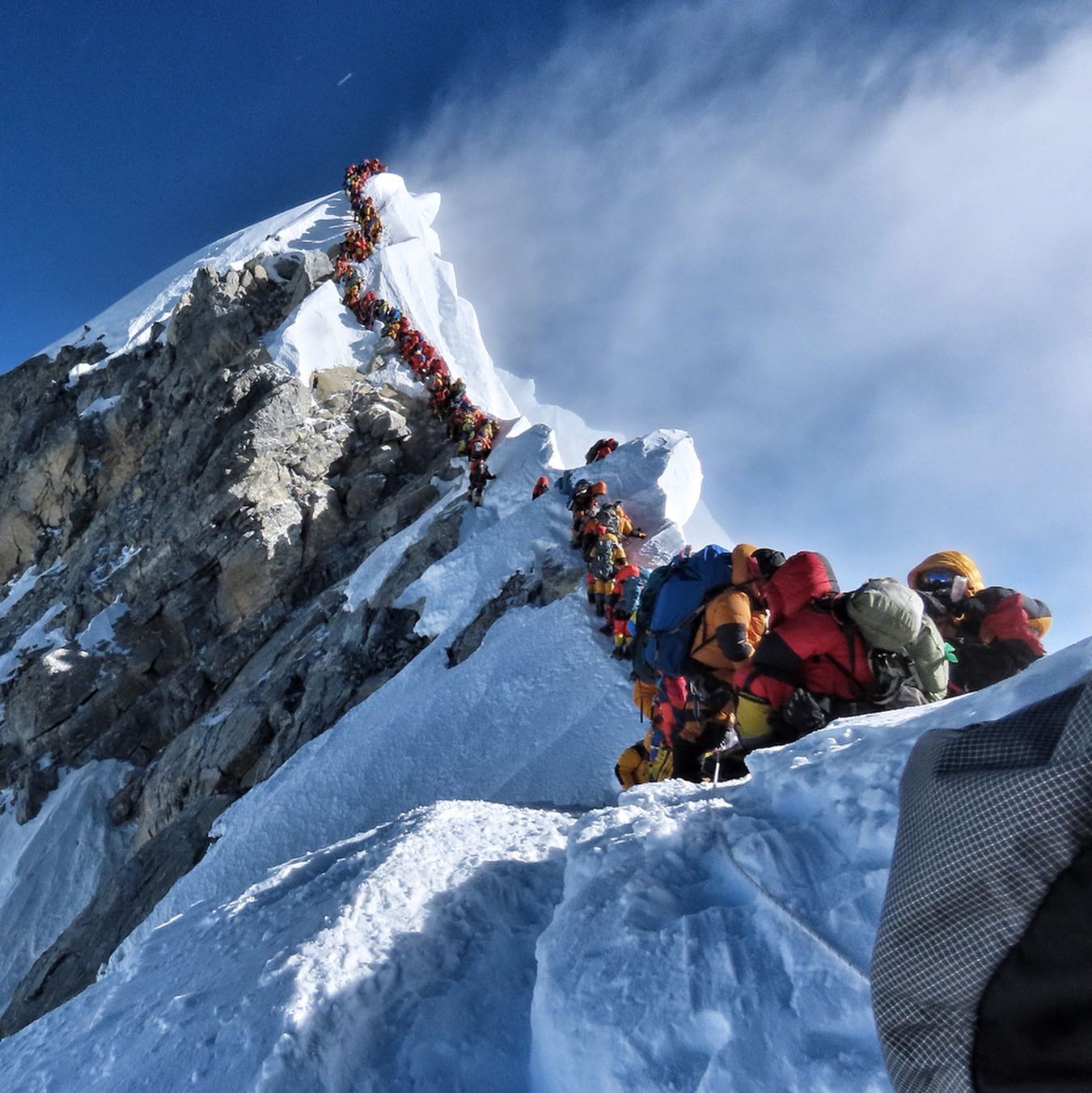
Traffic Jam on Everest Photo Courtesy: Nirmal Purja Facebook
Dream Wanderlust reached out to few sternly accomplished Sherpas - the ice doctors of the Himalayas. Few of them are the rope-fixing team members who opened the route for several prime eight-thousanders this spring.
We broadly asked their viewpoint on two areas as follows:
- This year, weather was neither so bad for climbing, nor any natural disaster was reported. Still 21 climbers had lost their lives on eight-thousanders. Why?
- Amongst them, only on the Everest, the death toll is 11. What are the driving factors behind so many deaths this year?
Actually, this season was not for long weather window. Only 14-16th, 22nd, and 23rd May were appropriate for the summit push. But those days were also not perfect due to strong windy weather. Mostly Indians were dead. It proves that they hardly prepared themselves and they don't care about their guides’ decision. Also, I think they don't know much about how to handle self-energy above 8000m.”
Ang Phurba summitted the world's highest peak as one of the rope-fixing team members this year, opening the route.
This is the saddest year in the history of climbing 8000ers. It was a record year on Everest from Nepal side where permits for 381 climbers were issued. 381 would be twice if we provide 1member:1sherpa which means more than 750 climbers are just on Everest. In the beginning, the weather on Everest was unpredictable as most of weather report didn’t match. That made us worry about the weather. Once the rope was fixed to summit on 14th May, summit bid started but still we had limited good windows. We had most of windy days before 14th May which made it difficult for all team to set up Camp-4. Because of this only few teams could make it to the summit on 15th and 16th May.
This year, I have seen more inexperienced guides and inexperienced climbers who are reason for their own accident. Like the Indian boy [Ravi Thakar], who died on 17th May, was found at 8600m and he was waiting there for help and was without oxygen. Ascent Himalaya agency’s Sherpa team while on the way to rescue a Chinese man, also rescued this Indian man and brought back to Camp-4 alive but he died to hyperthermia once he didn’t get enough help from his team member.
The Irish man [Seamus Sean Lawless] was lost somewhere at balcony and the reason is unknown. When he visited my camp with our member at Base Camp, he said he had supporting Sherpa. Where was his Sherpa when he got problem? This means his Sherpa was inexperienced.
Mrs. Kulkarni was not enough experienced to climb Everest. I know her from 2016 from having controversy with police couple who faked summit picture. They had big fight. Since then late Kulkarni was in contact with me regarding Everest and I know their experience. Sorry to say but more than 80% of Indian citizens are on Everest without previous 6000m or 7000m experience. If they come to climb Everest like this then there will be problem.
At present another big problem is inexperienced climbing Sherpa. Many Nepalese agencies in mood of making higher money, use new Sherpa where the Sherpa gets climbing opportunity and agency can use them in lower cost saying, “It’s your opportunity”. Then that adds accident.
Another problem is cost. Climbers try to find low rated price which means low rated service and cheap guide company. And it means they are seeking for problems.”
Mingma Sherpa is one of well-known UIAGM guides, the founder and Managing Director at Imagine Nepal and also, a Liaison officer at Nepal Tourism Board. Aside being a 5-time Everester, he has climbed 11 other 14 eight-thousanders many a times.
Dipankar Ghosh, while descending from the summit of Makalu, was suffering from acute exhaustion and decreasing level of oxygen. His Sherpa tried his level best to revive him back. He gave Dipankar his own oxygen to convince him to continue climbing down when he sat down because of HAPE. Had the Sherpa not started to come down, he would have also been dead with Dipankar since it was already very late.”
Shanu Sherpa, one of the rope-fixing team member of Makalu, who opened the route this year, talks about the fatality on Makalu.
This year we got a very short weather window – mostly lasted for 2-3 days between after irregular intervals. This made everyone rush to the summit at the same time which created the traffic. Traffic led to rapid loss of energy and that led to more use of the bottled oxygen on Everest.
But the fatality on Kanchenjunga happened for a different reason. We warned Kuntal (died before summit) to come down. Our team realized that his fitness was not up to the mark for such an expedition on Kanchenjunga to continue climbing in harsh weather. We aimed for reaching the summit at 8am which never happened due to their incompetence. They made the entire traffic stand still for hours on 15th May. Foreign climbers focus on their fitness before such expedition which Indian mountaineers don’t.”
Ang Babu Sherpa is the Managing Director at Peak Promotion Pvt. Ltd,. He also has reached the summit on 15th with the Indian team of which had 2 deaths.
The crowds were one piece of the puzzle...the puzzle of getting it right and standing on top, or not quite getting there. Other pieces were the weather that turned too windy and cold before I got to the top, and the thin feeble air that leaves no margin for waiting, getting cold, or allowing what happens to you to be influenced by the movements of others. After one successful expedition, they easily get the funding and overconfidence takes precedence over fitness.
Don’t get me wrong though, I agree that there is a problem; that Mount Everest is besieged by more people than she can handle, but I believe that the solution will only be found with considered thought and carefully planned actions: not by taking rash, knee-jerk, emotional decisions in a rush a second after we are flooded with emotive images of people in a line where we least expect it.
Let’s use our heads, our knowledge, our collective expertise and our respect of others and of the planet to solve this problem and take care of the highest mountain on earth”.
Göttler, a renowned UIAGM certified German climber-guide, abandoned Everest summit from 8650m, while climbing without supplemental oxygen this year. [Posted on his instagram account]
We should not demonize the climbers who realized a life dream to climb Mt. Everest. Nor should we demean the place. Are there problems as the mountain grows in popularity? Absolutely. Now is the time to aggressively address those problems. They are solvable. The mountain is not overcrowded. But regulations on commercial operators are desperately needed to require the experience of clients, Sherpa, mountain guides and expedition leaders. Even in a difficult season like this one, with few possible summit days, the herd mentality thinking that led to hundreds climbing on the same day and to multi-hour waits on the South Side, is completely unnecessary. Teams could have chosen slightly less ideal weather conditions to avoid crowds. They could have backed off and held at a camp an extra night when they saw the potential traffic jams. They could have utilized climbing techniques to leave the fixed ropes and move around bottlenecks. And they could have chosen alternative routes from the easiest (but busiest) South Side route (for reference, the route from Tibet (North Side) had 1/3 the number of climbers this year as compared to the South Side from Nepal).
We don't need fewer people to dream of climbing to the roof of the world. We need competent and courageous companies led by highly experienced mountain guides, willing to make hard decisions for safety regardless of their impact on the bottom line."
Adrian is an IFMGA/AMGA-certified alpinist, leading over 100 international expeditions with several of them without supplemental oxygen and traditional sherpa-support. [Posted on his instagram account]
What do the Statistics on Death signify?
Midst experts are still analyzing the expeditions to determine the whys and wherefores of the death reports, Spring-2019 has surpassed the death toll of Spring-2015 (18, due to avalanche, Himalayan Database) by two.
Amongst 21 this year, 8 of them are Indians, consisting two middle-aged women – Kalpana Dash (52) from Orisha, and Anjali Sharad Kulkarni (55) from Maharashtra on Everest. Two more – Ravi Thakar (28) and Nihal Bagwan (25) who died on Everest are said to have developed HAPE (High-altitude Pulmonary Edema) due to traffic jam leading to exhaustion above death zone.
Sounds unbelievable? According to the recent statistics shared by liaison officer Gyanendra Shrestha at Everest Base Camp, 122, 297, and 172 had attempted for the summit bid on 21st May to 23rd May. In total, 381 climbers were given the permits to climb Everest (from Nepal side) up till May 19, according to the latest report released by Department of Tourism at Government of Nepal. Besides, in total, 868 climbers received permits from Nepal's Tourism Department to summit the country's 30 peaks.
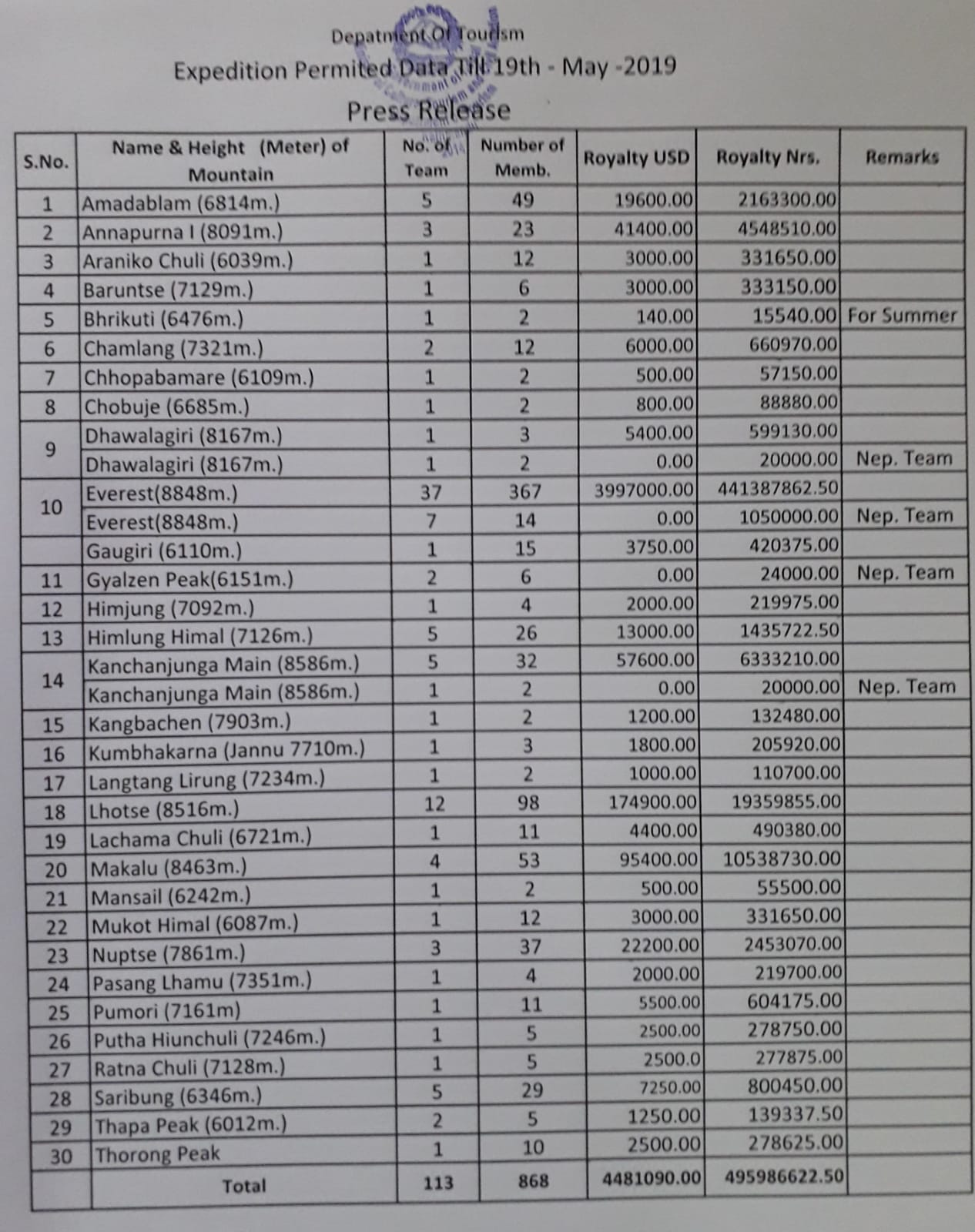
Number of Permits, issued by Department of Tourism, Government of Nepal
Himalayan Data Base says, Everest witnessed highest number of attempts - 19,554, until 2018 whereas Cho Oyu, Makalu, Lhotse, and Kanchenjunga comes later in the table in terms of number of attempts made so far. Figures read that the Kanchenjunga attracts only 5.75% of population coming to Everest – lowest rate, compared to Everest amongst all prime eight-thousanders in Nepal, that too at only 26.75% success rate. So is the case with Annapurna-I and Dhaulagiri-I.
Alongside the highest failure rate – 83.88%, on Annapurna-I, it only attracts 8.27% of the attempts made to Everest so far. As for Dhaulagiri, even though the success rate (21.52%) is higher than the summit of Annapurna (16.12%) and Makalu (20.52%), the number of attempts (2495, until 2018) is observed the 5th lowest; more than Kanchenjunga (1226), Annapurna (1619), Lhotse (2097), Makalu (2252). Though 2019 hasn’t seen any fatalities on Dhaulagiri, Romanian climber Horia Colibasano, Peter Hamor (53), and Marius Gane (51) decided to turn back due to strong wind prevailed on the mountain.
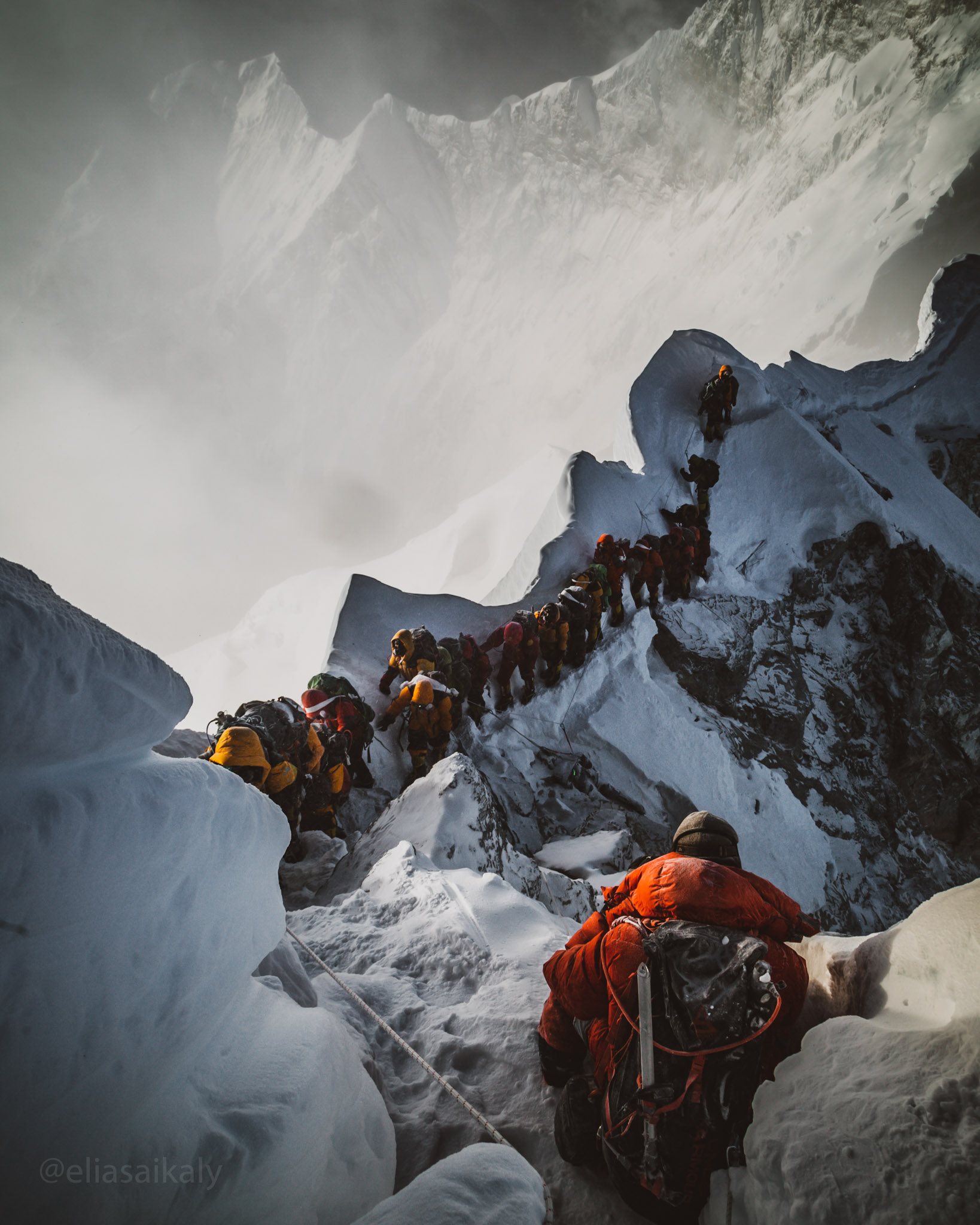
Traffic Jam on Everest Photo Courtesy: Elia Saikaly Facebook
Amidst the horrible intensification on rising death toll in the Himalayan eight-thousanders this spring,two Sherpas breathed their last on 24th May in the afternoon, one at Everest Base Camp and another during a rescue mission on Makalu.
Before that, one of the rope-fixing and route-opening team - Phujung Bhote Sherpa, died after falling into a crevasse while fixing rope near Camp-2 on Cho Oyu on April 29. According to the Himalayan Database, so far, more than half of the summit attempts have been failed at a rate of 57.52% even though 8630 (only 44.13% of Everest attempts) attempts have been made so far.
While the mortal remains of Indian climbers Dipankar Ghosh (53) and Naik Narayan Singh (35) were recovered on 25th May in the morning in a heroic mission, so far, Makalu witnessed four loss of lives. Surprisingly, the number of summits with and without oxygen on Makalu almost equate each other at 235 and 227 until 2018. Hitherto, while analyzing the expedition report, it is observed that only 11.51% of attempts made to Everest, give a shot on Makalu at a striking 79.48% failure rate. Yet, contrasting to the death of two Indian climbers, Peruvian hiker Richard Hidalgo (52) died of altitude sickness inside his tent at 20,066 feet on Makalu during a non-Sherpa-supported solo alpine-style expedition on May 8 this year amongst 53 climbers who attempted for Makalu.
Timeline of Deaths: Spring 2019 (peak wise, until 27th May)
EVEREST
1. Seamus Sean Lawless (39) on May 16Dublin, Ireland
Irish climber Seamus Sean Lawless, had slipped and gone missing since May 16 on Everest while descending from the summit nearby Camp-4. A team of nine climbers, led by his expedition leader Irish mountaineer Noel Richard Hanna, was formed to begin a search and recovery operation of Seamus, a Computer Science professor at Trinity College, Dublin. They were at South Col on May 23 to search for the deceased climber. Despite the best effort of search team, he remains untraceable for last 11 days.
2. Ravi Thakar (28) on May 17Tara Nagar, Sonipat, Haryana, India
While returning from the summit bid, Ravi, a software engineer, got stuck near Camp-4 due to traffic and lack of oxygen which led Ravi to develop Acute Mountain Sickness and extreme exhaustion. Even after Nepal government gave information to the Indian government on time, allegedly, the needful was never done on time to initiate the rescue mission which led to his untimely death inside Camp-4 early in the morning on May 17. He was part of same eight-member international team consisting Seamus Lawless, led by well-known Irish climber Noel Richard Hanna.
A statement, released by Trinity College on May 24, suggests that the rescue mission had been stopped to avoid deceitful conditions on the mountain. It reads as follows:
“While the experienced search team has made every effort to locate Shay [Seamus], the extremes of operating at high altitude and the sheer range of the search area ultimately proved too difficult and based on expert advice the Lawless family have decided to call off the search rather than risk endangering anyone’s life in the treacherous conditions.”
3. Anjali Sharad Kulkarni (55) on May 22Mumbai, Maharashtra, India
Thupden Sherpa, one of the peers at her expedition agency - Arun Treks and Expeditions, said she died of extreme exhaustion after standing at a long-awaiting queue near the summit ridge in death zone while descending from the summit bid. Her husband Sharad Kulkarni, who accompanied her through the expedition, successfully scaled the peak on the same day early in the morning. Kulkarni couple was part of the 6-member expedition team, led by Rabindra Kumar.
#Rescue Effort
— Dream Wanderlust (@DreamWanderlust) May 28, 2019
Sherpas trying to rescue Anjali Sharad Kulkarni (55), Indian climber who died on #Everest during her summit bid on May 22. #Spring2019 pic.twitter.com/wYz8q7eVpi
Sandy, Utah, United States
Cash, was a part of team, led by Pioneer Adventures. Even after the Sherpa team tried Cardio-Pulmonary Resuscitation to revive him back once he collapsed after reaching the summit, Donald Lynn Cash passed away near the Hillary Step on Everest. Climbing the Everest was the last patch of his pursuit to finish the Seven Summits on the highest peaks of seven continents. His daughter Danielle Cook said. "It was the big finishing aspect of his dreams.”
5. Nihal Bagwan (25) on May 23Maharastra, India
Babu Sherpa, the Managing Director at Peak Promotion Pvt Ltd, said that Bagwan breathed his last at Camp-4 on the Everest on the Nepal side after he was rescued by a group of Sherpas. He was descending from the summit towards Base Camp. Bagwan was the leader of a two-member expedition.
"The climber died at Camp-4 after he fell sick near the balcony while returning from the summit," Sherpa added.
Largely, his death was attributed to the same long queue of the climbers, as Anjali and Ravi, as it compelled many to await hours around death zone. Explaining the situation on the awaiting queue, Keshav Paudel of Peak Promotion said,
"He was stuck in the traffic for more than 12 hours and was exhausted. Sherpa guides carried him down to Camp-4 but he breathed his last there."
6. Kalpana Dash (52) on May 23Bhubaneshwar, Odisha, India
Kalpana, who previously climbed Everest in 2008, as the first female mountaineer from Odisha, has passed away just above the balcony after she became ill on the descent. She was, too, reportedly the victim of high traffic of both ascending and descending mountaineers around the death zone. Despite her Sherpas brought her to balcony area, her breathing had stopped. “She was the member of a three women expedition”, Gyanendra Shrestha, a government official at the Everest Base Camp said.
7. Ing Landgraf (Ernst) (65) on May 23Austria
Ing Landgraf died on 22nd May while on an expedition to Everest, by led by Kobler & Partner, from the Tibetan side, told Subash Shrestha, an official at Himalaya Vision Pvt Ltd.
8. Dhurba Bista (32) on May 24Kailali, Nepal
Dhurba, an affiliate of NNMGA (Nepal National Mountain Guide Association) and the Managing Director of Technical Himalaya Treks & Expedition, was on an expedition, planned by Himalayan Ski Treks. Supposedly, he fell sick during the summit of Everest near Camp-3 in the afternoon. Even a rapid evacuation by a rescue-helicopter back to the Base Camp could not save his life on the tallest mountain on earth, as per Gyanendra Shrestha inferred from the Base Camp.
9. Kevin Hynes (56) on May 24Newbridge, Galway, Ireland
He is the second Irish climber to have perished in this spring on Everest after Seamus Lawless on May 16. 360 Expeditions, his climbing agency released a statement that reads, “Kevin (56) was one of the strongest and most experienced climbers on our team and had previously summited Everest South and Lhotse,” He passed away inside his tent at the North Col, at 7,000m above sea level, in the early hours. He was climbing Everest from North (Tibet side) under the guidance of Dawa Sangee – a summitter of Everest South twice, Everest North and Makalu twice. He climbed Everest last year as well.
10. Robin Haynes Fisher (44) on May 25Birmingham, United Kingdom
Robin Haynes Fisher breathed his last amid overcrowding above 8600m while returning from the summit of Everest. Murari Sharma, Managing Director at Everest Pariwar Treks, confirmed that the British climber was part of a 6-member team, led by Dani Fuller. They made it to the summit at around 8:30am,” Fisher died below the summit while the Jangbu Sherpa and other guides had taken him down to the lower camp.
11. Christopher John Kulish (61) on May 27Boulder, United States
Kulish, a patent lawyer and climber, scaled Everest peak through the Southeast Ridge route on 27th in the morning but suddenly passed away, possibly at South Col while descending from the summit, Mira Acharya, a Nepal tourism department official reported. He is the 2nd American to have died within 5 days after Utah man Don Cash died on 22nd May.
MAKALU
12. Richard Hidalgo (52) on May 8Santiago de Surco, Peru
He was found dead by the Sherpas inside his tent at Camp-2 on Makalu. He was climbing without supplemental oxygen in alpine style with almost no Sherpa support. He was the first Peruvian to climb a mountain in Pakistan, also, the only mountaineer from Peru to have climbed five eight-thousanders - Shisha Pangma (8027m), the Cho Oyu (8201m), Manaslu (8163m), the Annapurna (8091m) and the Gasherbrum II (8035m) without supplemental oxygen. Unfortunately, he died before his target to finish all the 14 eight-thousanders before 2021 without the aid of oxygen.
13. Dipankar Ghosh (53) on May 16Bally, West Bengal, India
Dipankar reportedly went missing while he was descending from the summit of Makalu above 8200m nearby the summit bid. Dipankar's last contact with the Base Camp was around 7:00pm on 16th May. He previously climbed Everest, Kanchenjunga, Manaslu, Annapurna, and a many other mountains in India and Nepal.
A Sherpa team, led by Chhang Dawa Sherpa, rescued the remains of deceased mountaineer from West Bengal. Mingma David Sherpa, the legendary Sherpa of the Project Possible team, who summited Kangchenjunga, Annapurna and Dhaulagiri in last one month, was reportedly part of the rescue team, alongside, Tashi Sherpa, from Seven Summit Treks.
14. Naik Narayan Singh (35) on May 16Pithoragarh, Uttarakhand, India
Narayan Singh, one of the 16-member Indian Army expedition team to Makalu, supposedly breathed his last above the elevation of 8200m while descending from the summit point on last Thursday. Eventually, it was impossible to start the rescue mission before May 22 since there was already a lot of rescue missions in progress due to 10 other sudden demise of mountaineers by 16th May. After an enigmatic postponement of eight days, the mortal remains of Dipankar Ghosh and Narayan Singh had finally been rescued on 25th May after an intervention of Ministry of Foreign Affairs, Government of India and Indian Embassy in Nepal.
15. Nima Tshering Sherpa on May 24Sankhuwasabha, Nepal
Nima, one of the 14-member search-and rescue team, was found dead on Makalu on 24th May in the afternoon. After the heroic recovery of almost untraceable Indian climbers Dipankar Ghosh (53) and Naik Narayan Singh (35), Nima Tshering Sherpa, has died today in the afternoon, as reported by Pashang Sherpa on May 24. “It is very unfortunate of the team to have lost the Sherpa during the rescue operation. The exact reason for the accident which led to the sudden demise of Nima, is yet to be clear once the entire team safely comes back to the Base Camp,” he said previously.
KANCHENJUNGA
16. Biplab Baidya (48) on May 15He died above Camp-4 of Kanchenjunga while descending from the summit of the 3rd highest mountain on May 15, says Nirmal Purja, who brought him down from Camp-4 with along with fellow members - Mingma David Sherpa, Gesman Tamang, and Pasang Sherpa, director of the expedition agency Peak Promotion Pvt. Ltd. He reportedly developed hypothermia and snow-blindness above 8200m due to decreasing level of oxygen.
17. Kuntal Karar (46) on May 15Howrah, West Bengal, India
As a part of same 5-member group as Biplab’s, Kuntal, was also on the ascent route but failed to reach the summit, succumbing to high-altitude sickness which led to his death above Camp-4 itself. Both of their mortal remains are brought back to their hometown on May 26, after the successful rescue operation by a team of six Sherpas from Peak Promotion Agency.
18. Rodrigo Vivanco, on May 15Peru
Rodrigo Vivanco had gone missing above Camp-4 of Kanchenjunga since May 15 in the evening. He was on an extreme alpine style solo expedition without the aid of supplemental oxygen. Reportedly, the Sherpas at the base camp lost contact with him around at 8400m while he was descending from the summit bid. According to Pasang Sherpa, the director of Peak Promotion agency, a rescue team was mobilized up in the mountain to conduct a search and recovery operation which was later called off after Rodrigo’s family lost hope.
ANNAPURNA
19. Wui Kin Chin (48) Annapurna May 3Singapore
He reached the summit of Annapurna on April 23 in the afternoon but failed to return to the nearest camp, while he was stranded during the descent. He was part of a 13-member expedition, led by French climber Barobian Michel Christian. A high-altitude rescue team, comprising Nirmal Purja, Mingma David Sherpa, Galgen Sherpa and Gesman Tamang was sent from the Base Camp to evacuate the climber. The rescuers brought back Kin to Camp-3 on 25th April, followed by an airlift to Kathmandu. Later, he died back at home due to reasons still unknown.
CHO OYU
20. Phujung Bhote Sherpa April 29Nepal
He fell into a crevasse while climbing the mountain as one of the rope-fixing team near Camp-2.
LHOTSE
21. Ivan Yuriev Tomov (35) on May 17Ruse, Bulgaria
This Bulgarian Alpinist died at Camp-4 of Lhotse while descending from the summit. Reportedly, he was climbing without supplemental oxygen together with Nastya Runova from Russia. He was the 3rd Bulgarian to have reached the summit of Lhotse and 2nd Bulgarian to do it without the aid of supplemental oxygen. He also has climbed Broad Peak and Manaslu without oxygen in 2014 and 2017.
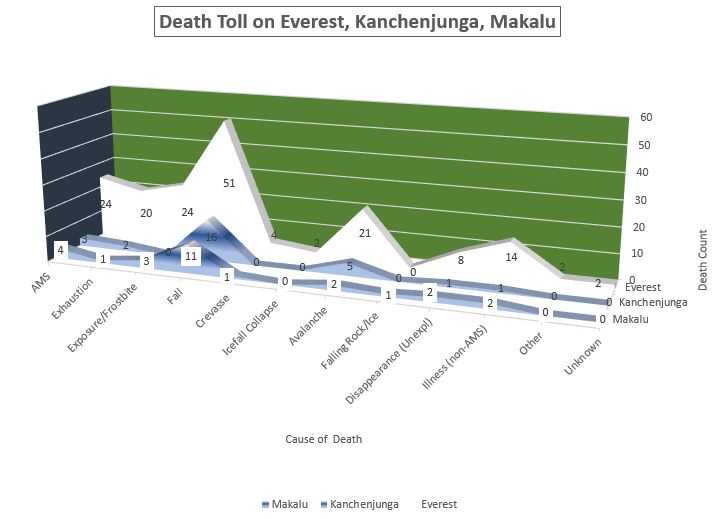
*Data collected from Himalayan Database until Spring 2018
Photo Courtesy: Nirmal Purja and Elia Saikaly Facebook
Subscribe Us On YouTube
Related News
Address: Ogg Road, Noapara, Shyamnagar, North 24 PGS, West Bengal - 743127, India
E-mail: dreamwanderlust@gmail.com
City Office: 87/F Purba Sinthee Cross Road. Dum Dum, Kolkata - 700030






